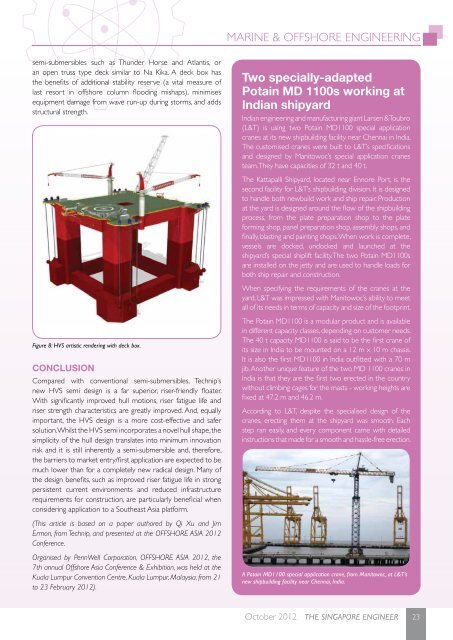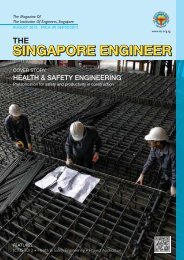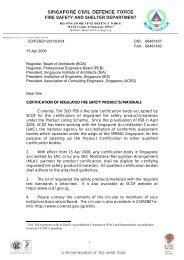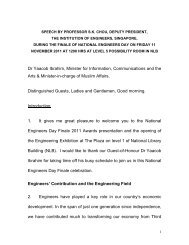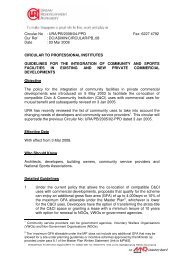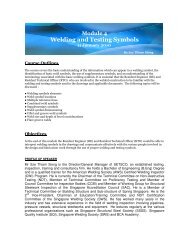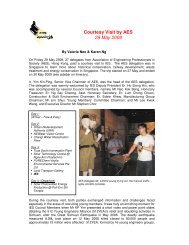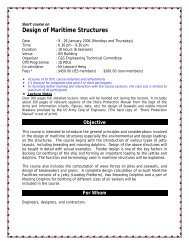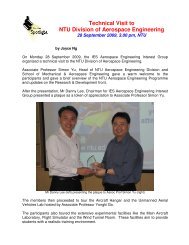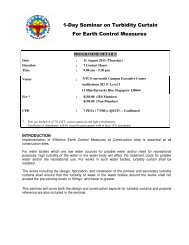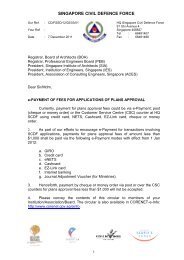singapore engineer singapore engineer singapore engineer
singapore engineer singapore engineer singapore engineer
singapore engineer singapore engineer singapore engineer
You also want an ePaper? Increase the reach of your titles
YUMPU automatically turns print PDFs into web optimized ePapers that Google loves.
MARINE & OFFSHORE ENGINEERING<br />
semi-submersibles such as Thunder Horse and Atlantis, or<br />
an open truss type deck similar to Na Kika. A deck box has<br />
the benefits of additional stability reserve (a vital measure of<br />
last resort in offshore column flooding mishaps), minimises<br />
equipment damage from wave run-up during storms, and adds<br />
structural strength.<br />
Figure 8: HVS artistic rendering with deck box.<br />
CONCLUSION<br />
Compared with conventional semi-submersibles, Technip’s<br />
new HVS semi design is a far superior, riser-friendly floater.<br />
With significantly improved hull motions, riser fatigue life and<br />
riser strength characteristics are greatly improved. And, equally<br />
important, the HVS design is a more cost-effective and safer<br />
solution. Whilst the HVS semi incorporates a novel hull shape, the<br />
simplicity of the hull design translates into minimum innovation<br />
risk and it is still inherently a semi-submersible and, therefore,<br />
the barriers to market entry/first application are expected to be<br />
much lower than for a completely new radical design. Many of<br />
the design benefits, such as improved riser fatigue life in strong<br />
persistent current environments and reduced infrastructure<br />
requirements for construction, are particularly beneficial when<br />
considering application to a Southeast Asia platform.<br />
(This article is based on a paper authored by Qi Xu and Jim<br />
Ermon, from Technip, and presented at the OFFSHORE ASIA 2012<br />
Conference.<br />
Organised by PennWell Corporation, OFFSHORE ASIA 2012, the<br />
7th annual Offshore Asia Conference & Exhibition, was held at the<br />
Kuala Lumpur Convention Centre, Kuala Lumpur, Malaysia, from 21<br />
to 23 February 2012).<br />
Two specially-adapted<br />
Potain MD 1100s working at<br />
Indian shipyard<br />
Indian <strong>engineer</strong>ing and manufacturing giant Larsen & Toubro<br />
(L&T) is using two Potain MD1100 special application<br />
cranes at its new shipbuilding facility near Chennai in India.<br />
The customised cranes were built to L&T’s specifications<br />
and designed by Manitowoc’s special application cranes<br />
team. They have capacities of 32 t and 40 t.<br />
The Kattapalli Shipyard, located near Ennore Port, is the<br />
second facility for L&T’s shipbuilding division. It is designed<br />
to handle both newbuild work and ship repair. Production<br />
at the yard is designed around the flow of the shipbuilding<br />
process, from the plate preparation shop to the plate<br />
forming shop, panel preparation shop, assembly shops, and<br />
finally, blasting and painting shops. When work is complete,<br />
vessels are docked, undocked and launched at the<br />
shipyard’s special shiplift facility.The two Potain MD1100s<br />
are installed on the jetty and are used to handle loads for<br />
both ship repair and construction.<br />
When specifying the requirements of the cranes at the<br />
yard, L&T was impressed with Manitowoc’s ability to meet<br />
all of its needs in terms of capacity and size of the footprint.<br />
The Potain MD1100 is a modular product and is available<br />
in different capacity classes, depending on customer needs.<br />
The 40 t capacity MD1100 is said to be the first crane of<br />
its size in India to be mounted on a 12 m x 10 m chassis.<br />
It is also the first MD1100 in India outfitted with a 70 m<br />
jib. Another unique feature of the two MD 1100 cranes in<br />
India is that they are the first two erected in the country<br />
without climbing cages for the masts - working heights are<br />
fixed at 47.2 m and 46.2 m.<br />
According to L&T, despite the specialised design of the<br />
cranes, erecting them at the shipyard was smooth. Each<br />
step ran easily, and every component came with detailed<br />
instructions that made for a smooth and hassle-free erection.<br />
A Potain MD1100 special application crane, from Manitowoc, at L&T’s<br />
new shipbuilding facility near Chennai, India.<br />
October 2012 THE SINGAPORE ENGINEER<br />
23


